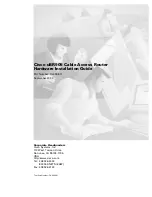
Viper User
Manual (001-5008-000 Rev6)
Page
16
SYSTEM ARCHITECTURE AND NETWORK PLANNING
This section briefly discusses network architecture (including basic network types),
interfacing modems and DTE, data protocols for efficient channel operation, addressing, and
repeaters.
Viper is designed to replace wire lines in SCADA, telemetry and control applications. The
Ethernet and RS-232 serial port allows direct connection to Programmable Logic Controllers
(PLCs) or Remote Terminal Units (RTUs). A SCADA system is defined as one or more
centralized control sites used to monitor and control remote field devices over wide areas.
For example, a regional utility may monitor and control networks over an entire
metropolitan area. Industry sectors with SCADA systems include energy utilities, water and
wastewater utilities, and environmental groups.
The Viper is intended for use in the Industrial Monitoring and SCADA market. The range of
the Viper is dependent on terrain, RF (radio frequency) path obstacles, and antenna system
design. This section provides tips for selecting an appropriate site, choosing an antenna
system, and reducing the chance of harmful interference.
SINGLE COVERAGE AREA
In a network topology with only a single coverage area (all units can talk to one another
directly), there are several common system configurations.
The most common is for one unit to be designated as a master and the rest designated as
remotes. Another system configuration is Report-by-Exception.
MASTER/REMOTE
In a Viper network, Vipers are not programmed to be masters or remotes. All Vipers in a
network can be configured the same. However, a unit can be configured as an Access Point.
The unit configured as an Access Point would allow access to the Internet, but an Access
Point is not required in all networks. Most SCADA networks have a “polling master”, but the
polling master is not necessarily configured any different than the remotes. It is the
responsibility of the polling master to control RF traffic so RF collisions do not occur.
Note: In a radio system, only one radio should transmit at a time. If two radios
transmit at the same time to another radio, RF collisions occur. Collisions will
slow data traffic and possibly corrupt data.
The Viper has RF collision avoidance technology (checks the air wave for a carrier before
transmitting) and Ethernet CSMA (Carrier Sense Multiple Access). CSMA is an Ethernet
collision avoidance mechanism technology built into to all Ethernet connections. These
technologies still need to be supplemented by the HMI/PLC polling master to optimize RF
data traffic.
Some HMI/PLC Ethernet applications may depend solely on Ethernet CSMA to control the
flow of messages to avoid RF collisions in a Viper network. This may flood the network with
multiple polling messages, making it difficult for the RTUs to acquire the airwave to transmit
their reply messages. This will cause the RTUs to compete for airtime and a dominant RTU
may be created.
While the dominant RTU/radio is transmitting, the other RTUs will send their reply messages
to their connected Viper. Vipers will buffer reply messages because the dominant RTU/radio
is transmitting (carrier is present). A Viper will buffer (while a carrier is present) a reply
message until it can capture the airwave (carrier absent) to transmit. There could be five or
six RTU/radios in a small system (or 10 or 20 in a large system), which could be trying to
capture the airwaves to transmit. The RTUs will not respond in the order they were polled
















































